AVL Trees
In the previous section we looked at building a binary search tree. As
we learned, the performance of the binary search tree can degrade to
for operations like get and put when the tree becomes
unbalanced. In this section we will look at a special kind of binary
search tree that automatically makes sure that the tree remains balanced
at all times. This tree is called an AVL tree after its
inventors: G.M. Adelson-Velskii and E.M. Landis. We have decided to focus on AVL trees as an example of self-balancing binary search trees, but there are many others such as the popular red-black tree.
An AVL tree implements the Map abstract data type just like a regular binary search tree, the only difference is in how the tree performs. To implement our AVL tree we need to keep track of a balance factor for each node in the tree. We do this by looking at the heights of the left and right subtrees for each node. More formally, we define the balance factor for a node as the difference between the height of the left subtree and the height of the right subtree.
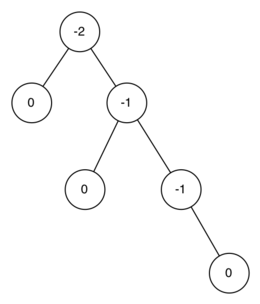
Before we proceed any further let’s look at the result of enforcing this new balance factor requirement. Our claim is that by ensuring that a tree always has a balance factor of -1, 0, or 1 we can get better big O performance of key operations. Let us start by thinking about how this balance condition changes the worst-case tree. There are two possibilities to consider, a left-heavy tree and a right heavy tree. If we consider trees of heights 0, 1, 2, and 3, The diagram below illustrates the most unbalanced left-heavy tree possible under the new rules.
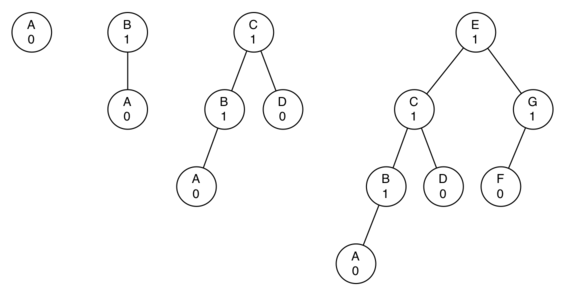
Looking at the total number of nodes in the tree we see that for a tree of height 0 there is 1 node, for a tree of height 1 there is nodes, for a tree of height 2 there are and for a tree of height 3 there are . More generally the pattern we see for the number of nodes in a tree of height h () is:
Implementation
Now that we have demonstrated that keeping an AVL tree in balance is going to be a big performance improvement, let us look at how we will augment the procedure to insert a new key into the tree. Since all new keys are inserted into the tree as leaf nodes and we know that the balance factor for a new leaf is zero, there are no new requirements for the node that was just inserted. But once the new leaf is added we must update the balance factor of its parent. How this new leaf affects the parent’s balance factor depends on whether the leaf node is a left child or a right child. If the new node is a right child the balance factor of the parent will be reduced by one. If the new node is a left child then the balance factor of the parent will be increased by one. This relation can be applied recursively to the grandparent of the new node, and possibly to every ancestor all the way up to the root of the tree. Since this is a recursive procedure let us examine the two base cases for updating balance factors:
- The recursive call has reached the root of the tree.
- The balance factor of the parent has been adjusted to zero. You should convince yourself that once a subtree has a balance factor of zero, then the balance of its ancestor nodes does not change.
We will implement the AVL tree as a subclass of BinarySearchTree.
To begin, we will override the _put method and write a new
update_balance helper method. These methods are shown below. You
will notice that the definition for _put is exactly the same as in
simple binary search trees except for the additions of the calls to
update_balance.
from binary_search_tree import BinarySearchTree, TreeNode
class AVLTreeNode(TreeNode):
def __init__(self, *args, **kwargs):
super(AVLTreeNode, self).__init__(*args, **kwargs)
self.balance_factor = 0
class AVLTree(BinarySearchTree):
TreeNodeClass = AVLTreeNode
def _put(self, key, val, node):
if key < node.key:
if node.left:
self._put(key, val, node.left)
else:
node.left = self.TreeNodeClass(key, val, parent=node)
self.update_balance(node.left)
else:
if node.right:
self._put(key, val, node.right)
else:
node.right = self.TreeNodeClass(key, val, parent=node)
self.update_balance(node.right)
def update_balance(self, node):
if node.balance_factor > 1 or node.balance_factor < -1:
self.rebalance(node)
return
if node.parent is not None:
if node.is_left_child():
node.parent.balance_factor += 1
elif node.is_right_child():
node.parent.balance_factor -= 1
if node.parent.balance_factor != 0:
self.update_balance(node.parent)
The new update_balance method is where most of the work is done. This
implements the recursive procedure we just described. The
update_balance method first checks to see if the current node is out of
balance enough to require rebalancing. If that is the case
then the rebalancing is done and no further updating to parents is
required. If the current node does not require rebalancing then the
balance factor of the parent is adjusted. If the balance factor of the
parent is non-zero then the algorithm continues to work its way up the
tree toward the root by recursively calling update_balance on the
parent.
When a rebalancing of the tree is necessary, how do we do it? Efficient rebalancing is the key to making the AVL Tree work well without sacrificing performance. In order to bring an AVL Tree back into balance we will perform one or more rotations on the tree.
To understand what a rotation is let us look at a very simple example. Consider the tree in the left half of the illustration below. This tree is out of balance with a balance factor of -2. To bring this tree into balance we will use a left rotation around the subtree rooted at node A.
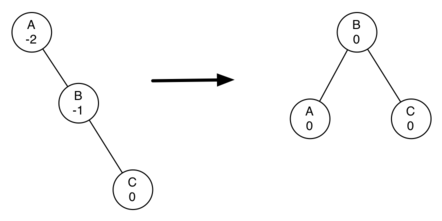
To perform a left rotation we essentially do the following:
- Promote the right child (B) to be the root of the subtree.
- Move the old root (A) to be the left child of the new root.
- If new root (B) already had a left child then make it the right child of the new left child (A). Note: Since the new root (B) was the right child of A the right child of A is guaranteed to be empty at this point. This allows us to add a new node as the right child without any further consideration.
While this procedure is fairly easy in concept, the details of the code are a bit tricky since we need to move things around in just the right order so that all properties of a Binary Search Tree are preserved. Furthermore we need to make sure to update all of the parent pointers appropriately.
Let’s look at a slightly more complicated tree to illustrate the right rotation. The left side of the illustration below shows a tree that is left-heavy and with a balance factor of 2 at the root. To perform a right rotation we essentially do the following:
- Promote the left child (C) to be the root of the subtree.
- Move the old root (E) to be the right child of the new root.
- If the new root(C) already had a right child (D) then make it the left child of the new right child (E). Note: Since the new root (C) was the left child of E, the left child of E is guaranteed to be empty at this point. This allows us to add a new node as the left child without any further consideration.
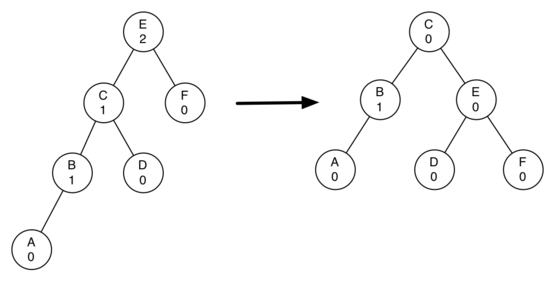
Now that you have seen the rotations and have the basic idea of how a rotation works let us look at the code below for both the left rotations. First we create a temporary variable to keep track of the new root of the subtree. As we said before the new root is the right child of the previous root. Now that a reference to the right child has been stored in this temporary variable we replace the right child of the old root with the left child of the new.
The next step is to adjust the parent pointers of the two nodes. If
new_root has a left child then the new parent of the left child becomes
the old root. The parent of the new root is set to the parent of the old
root. If the old root was the root of the entire tree then we must set
the root of the tree to point to this new root. Otherwise, if the old
root is a left child then we change the parent of the left child to
point to the new root; otherwise we change the parent of the right child
to point to the new root. Finally we set the parent of
the old root to be the new root. This is a lot of complicated
bookkeeping, so we encourage you to trace through this function while
looking at the diagram above.
def rotate_left(self, rotation_root):
new_root = rotation_root.right
rotation_root.right = new_root.left
if new_root.left is not None:
new_root.left.parent = rotation_root
new_root.parent = rotation_root.parent
if not rotation_root.parent:
self.root = new_root
else:
if rotation_root.is_left_child():
rotation_root.parent.left = new_root
else:
rotation_root.parent.right = new_root
new_root.left = rotation_root
rotation_root.parent = new_root
rotation_root.balance_factor = \
rotation_root.balance_factor + 1 - min(new_root.balance_factor, 0)
new_root.balance_factor = \
new_root.balance_factor + 1 + max(rotation_root.balance_factor, 0)
def rotate_right(self, rotation_root):
new_root = rotation_root.left
rotation_root.left = new_root.right
if new_root.right is not None:
new_root.right.parent = rotation_root
new_root.parent = rotation_root.parent
if not rotation_root.parent:
self.root = new_root
else:
if rotation_root.is_right_child():
rotation_root.parent.right = new_root
else:
rotation_root.parent.left = new_root
new_root.right = rotation_root
rotation_root.parent = new_root
rotation_root.balance_factor = \
rotation_root.balance_factor + 1 - min(new_root.balance_factor, 0)
new_root.balance_factor = \
new_root.balance_factor + 1 + max(rotation_root.balance_factor, 0)
The last two lines require some explanation. In these lines we update the balance factors of the old and the new root. Since all the other moves are moving entire subtrees around the balance factors of all other nodes are unaffected by the rotation. But how can we update the balance factors without completely recalculating the heights of the new subtrees? The following derivation should convince you that these lines are correct.
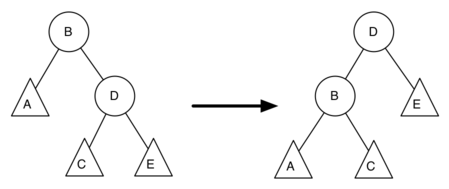
Above we see a left rotation. B and D are the pivotal nodes and A, C, E are their subtrees. Let denote the height of a particular subtree rooted at node . By definition we know the following:
rotation_root and D is new_root then we can see this
corresponds exactly to the statement on the penulitmate line, or:
rotation_root.balance_factor = \
rotation_root.balance_factor + 1 - min(0, new_root.balance_factor)
A similar derivation gives us the equation for the updated node D, as well as the balance factors after a right rotation. We leave these as exercises for you.
Now you might think that we are done. We know how to do our left and right rotations, and we know when we should do a left or right rotation, but take a look at the diagram below. Since node A has a balance factor of -2 we should do a left rotation. But, what happens when we do the left rotation around A?
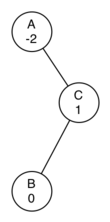
The diagram below shows us that after the left rotation we are now out of balance the other way. If we do a right rotation to correct the situation we are right back where we started.
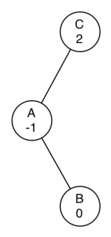
To correct this problem we must use the following set of rules:
- If a subtree needs a left rotation to bring it into balance, first check the balance factor of the right child. If the right child is left heavy then do a right rotation on right child, followed by the original left rotation.
- If a subtree needs a right rotation to bring it into balance, first check the balance factor of the left child. If the left child is right heavy then do a left rotation on the left child, followed by the original right rotation.
The diagram below shows how these rules solve the dilemma we encountered above. Starting with a right rotation around node C puts the tree in a position where the left rotation around A brings the entire subtree back into balance.
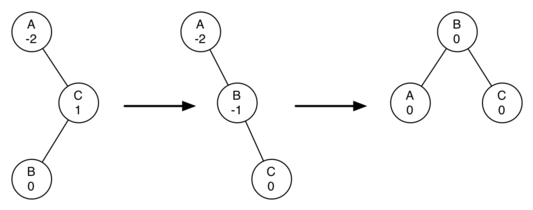
The code that implements these rules can be found in our rebalance
method, which is shown below. Rule number
1 from above is implemented by the if statement starting on line 2.
Rule number 2 is implemented by the elif statement starting on line 8.
def rebalance(self, node):
if node.balance_factor < 0 and node.right:
if node.right.balance_factor > 0:
self.rotate_right(node.right)
self.rotate_left(node)
else:
self.rotate_left(node)
elif node.balance_factor > 0 and node.left:
if node.left.balance_factor < 0:
self.rotate_left(node.left)
self.rotate_right(node)
else:
self.rotate_right(node)
By keeping the tree in balance at all times, we can ensure that the
get method will run in order time. But the question is
at what cost to our put method? Let us break this down into the
operations performed by put. Since a new node is inserted as a leaf,
updating the balance factors of all the parents will require a maximum
of operations, one for each level of the tree. If a subtree
is found to be out of balance a maximum of two rotations are required to
bring the tree back into balance. But, each of the rotations works in
time, so even our put operation remains .
At this point we have implemented a functional AVL-Tree, unless you need the ability to delete a node. We leave the deletion of the node and subsequent updating and rebalancing as an exercise for you.
Over the past few sections we have looked at several data structures that can be used to implement the map abstract data type. A binary Search on a list, a hash table, a binary search tree, and a balanced binary search tree. To conclude this section, let’s summarize the performance of each data structure for the key operations defined by the map ADT.
| operation | Sorted List | Hash Table | Binary Search Tree | AVL Tree |
|---|---|---|---|---|
put |
||||
get |
||||
in |
||||
del |